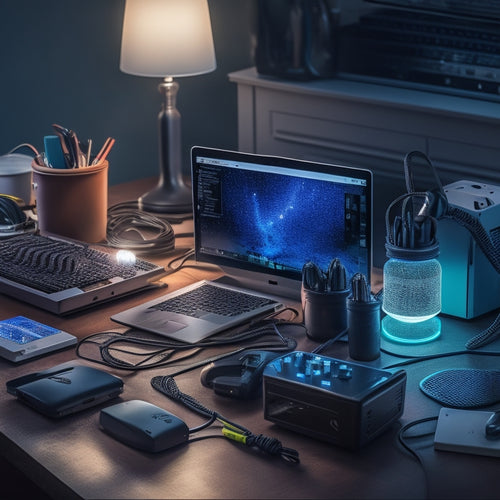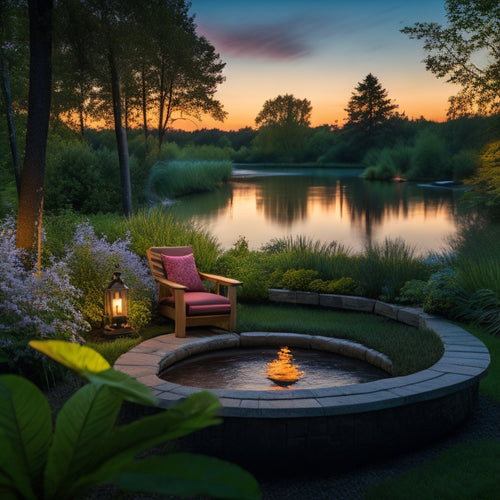
10 Tips: Minimize Energy Use With LED Landscape Lighting
Share
By upgrading to energy-efficient LED outdoor illumination, you can slash your outdoor lighting energy consumption by up to 75%. To achieve this, choose fixtures with high lumens-per-watt ratings, assess the quality of LED chips, and prioritize durability and longevity. Optimize your lighting design and layout by implementing a zone lighting strategy, allocating appropriate light levels, and spacing pathway lights 6-8 feet apart. Consider color temperature and CRI, use timers and schedules effectively, and select LED bulbs with a long lifespan. With these tips, you'll be well on your way to minimizing energy use - and there's even more to investigate to maximize your energy savings.
Key Takeaways
- Opt for LED fixtures with high lumens-per-watt ratings (50-70 lumens per watt) for maximum energy efficiency in pathway lights.
- Implement zone lighting to allocate appropriate light levels, minimizing energy waste and enhancing functionality in different areas.
- Automate lighting with programmed timers, motion sensors, and smart controls to reduce energy waste and optimize energy usage.
- Choose LED bulbs with high-quality chips, high efficacy (lumens per watt), and high CRI (80+) for improved performance, lifespan, and energy efficiency.
- Consider solar-powered solutions and renewable energy sources to reduce reliance on traditional power sources and lower carbon footprint.
Choose Energy-Efficient LED Fixtures
When selecting LED outdoor lighting fixtures, opting for energy-efficient options is vital to minimize energy consumption.
You'll want to take into account fixture styles that not only reduce energy waste but also provide the desired ambiance and functionality. Look for fixtures with high lumens-per-watt ratings, as they'll provide more light while using less energy. For instance, LED pathway lights with a rating of 50-70 lumens per watt are ideal for illuminating walkways.
Furthermore, adopting solar-powered charging stations for electric fleets can also contribute to a sustainable future solar energy utilization, which is important for mitigating volatility in fuel prices and enhancing operational efficiency.
Additionally, contemplate installation tips such as placing fixtures in areas where they can be easily accessed for maintenance, and using wire connectors that won't corrode over time.
Optimize Lighting Design and Layout
You'll want to implement a zone lighting strategy, which involves dividing your outdoor space into specific areas, each with its own unique lighting requirements.
This approach allows you to allocate the right amount of light exactly where it's needed, minimizing energy waste. By strategically placing lighting pathways, you can create a visually appealing and functional design that guides visitors through your outdoor space.
As you design your lighting layout, consider incorporating solar-powered solutions to reduce your reliance on traditional power sources and lower your carbon footprint.
This won't only minimize energy use but also support environmentally friendly practices.
Zone Lighting Strategy
Break down your outdoor space into zones to maximize the effect of your LED outdoor setting lighting.
This zone lighting strategy allows you to allocate the right amount of light to specific areas, reducing energy waste and increasing energy efficiency.
By creating distinct lighting zones, you can control the ambiance and functionality of each area separately.
As we move towards a greener environment, it's crucial to reflect on solar-powered EV chargers and their impact on our carbon footprint.
Implementing energy-efficient solutions like zone lighting can contribute to a more sustainable future.
To create an effective zone lighting strategy, reflect on the following:
-
Task zones: Focus lighting on areas that require functional lighting, such as outdoor kitchens, stairs, or entryways.
-
Ambient zones: Use softer lighting to create a relaxing atmosphere in areas like patios or gardens.
-
Accent zones: Highlight specific features like water features, statues, or structural details with targeted lighting.
Lighting Pathway Placement
Positioning LED pathway lights strategically along walkways and driveways not only enhances safety but also accentuates your outdoor space's beauty.
To enhance pathway illumination, you'll want to space lights 6-8 feet apart, depending on the fixture's lumen output. This will create a soft, even glow that guides visitors through your outdoor space.
By shifting to renewable energy sources like solar power, you can minimize your carbon footprint and reduce energy bills.
For ideal lighting aesthetics, consider the beam angle and color temperature of your pathway lights. Warm white LEDs (2700K-3000K) create a cozy ambiance, while cool white LEDs (3500K-4100K) provide a brighter, more energizing effect.
Select Appropriate Lumen Output
Lumen output, a critical factor in LED outdoor environment lighting, determines the brightness of your outdoor space. To select the right lumen output, you'll need to take into account the size of your outdoor area, the type of lighting you're using, and the desired level of brightness.
When choosing LED lights, it's crucial to take into account the high-efficiency solar panels that can power them, ensuring a cost-effective electricity generation and reducing reliance on fossil fuels. Similarly, integrating LED lights with existing infrastructure can provide real-time energy observations, optimizing overall energy use.
- Use a lumen calculator to determine the ideal lumen output based on your specific lighting needs.
- Reflect on the lumen distribution pattern of your LED lights, as this will affect how the light is dispersed throughout your outdoor space.
- Consider the ambiance you want to create: do you want a bright, task-oriented light or a softer, more ambient glow?
Consider Color Temperature and CRI
Frequently, LED outdoor lighting installations overlook two critical aspects: color temperature and color rendering index (CRI).
You want to guarantee the ambiance you create with your outdoor lighting aligns with your desired aesthetic. Color temperature, measured in Kelvin (K), affects color perception. Warm tones (2700K-3000K) create a cozy atmosphere, while cool tones (3500K-5000K) produce a brighter, more energizing effect.
CRI, ranging from 0-100, measures how accurately the light renders colors. A higher CRI (80-100) provides more lively colors, making it ideal for highlighting scenery features.
Use Timers and Schedules Effectively
You can greatly reduce energy consumption by implementing timers and schedules that align with your daily routines and outdoor activities. By doing so, you'll enjoy several timer benefits, including reduced energy waste and extended LED lifespan.
To maximize the effectiveness of your scheduling strategies, consider the following:
-
Automate your lighting: Program your timers to turn lights on and off at specific times, ensuring you never leave them on unnecessarily.
-
Adjust for seasonal changes: Update your schedules to account for daylight saving time, longer summer days, or shorter winter nights.
-
Create custom scenes: Designate specific lighting scenes for various activities, such as dining, entertaining, or relaxation, to optimize energy use and ambiance.
Implement Motion Sensors and Controls
Outdoor spaces equipped with motion sensors and controls become increasingly energy-efficient, as lights only illuminate when needed, eliminating unnecessary energy expenditure.
By strategically placing sensors in areas with high foot traffic, you can ascertain that lights turn on only when someone approaches. This targeted illumination not only reduces energy waste but also enhances safety and security.
To take it a step further, integrate your motion sensors with smart controls that allow you to customize lighting scenes and schedules. This seamless integration enables you to fine-tune your outdoor lighting system, granting you complete freedom to create an ambiance that suits your lifestyle.
With sensor placement and control integration, you'll be able to create a customized lighting experience that's both energy-efficient and visually stunning.
Select LED Bulbs With Long Lifespan
When selecting LED bulbs for your outdoor environment lighting, you'll want to choose options that provide a high lumen-per-watt rating to maximize energy efficiency.
Be sure to also consider the quality of the LED chip, as it directly impacts the bulb's overall performance and lifespan.
Lumen Per Watt Rating
Every LED bulb is rated for its lumen-per-watt performance, a critical metric that determines its energy efficiency.
When choosing an LED bulb, you want to maximize lumen efficiency while minimizing wattage consumption. A higher lumen-per-watt rating indicates a more energy-efficient bulb.
Here's what to look for:
-
Lumen efficiency: Opt for bulbs with a high lumen-per-watt rating (>80 lumens/watt) to guarantee maximum energy efficiency.
-
Watt comparison: Compare the wattage of different bulbs to guarantee you're not sacrificing brightness for energy efficiency.
-
Lumen output: Verify the lumen output meets your lighting needs, as higher wattage bulbs don't always translate to more lumens.
LED Chip Quality Matters
The quality of the LED chip is a critical factor in determining the lifespan of your LED outdoor lighting. When selecting LED bulbs, you'll come across different LED chip types, such as COB (chip-on-board), SMD (surface-mount device), or DIP (dual in-line package).
Each type has its own strengths and weaknesses, affecting LED performance metrics like efficacy, color temperature, and color rendering index. Look for high-quality LED chips with high efficacy (lumens per watt) and a high CRI (80+).
These will provide better light distribution, color accuracy, and energy efficiency. Be wary of low-cost options with inferior LED chips, as they may degrade quickly, reducing your lighting's overall performance and lifespan.
Rated Life Expectancy
You've likely noticed that LED bulbs are often rated to last a certain number of hours, typically ranging from 15,000 to 50,000 hours or more.
This lifespan is a critical factor to evaluate when selecting LED outdoor lighting. A longer lifespan means you'll replace bulbs less frequently, which reduces waste and minimizes the environmental impact of your lighting choices.
Here are three key benefits of choosing LED bulbs with a long lifespan:
-
Reduced maintenance: With fewer replacements needed, you'll save time and effort on upkeep.
-
Cost savings: Longer-lasting bulbs mean lower costs over time.
-
Environmental benefits: Less waste and reduced resource consumption contribute to a more sustainable future.
Reducefixture Quantity and Spacing
Maximizing fixture placement is essential when reducing energy use with LED outdoor lighting. By strategically placing fixtures, you can minimize the number of lights needed, resulting in significant energy savings.
Start by evaluating your outdoor space, identifying areas that require illumination and those that don't. Then, select fixtures with a design that allows for ideal spacing.
Spacing guidelines recommend placing path lights 8-10 feet apart, while spotlights can be spaced 10-15 feet apart. By following these guidelines and choosing fixtures with precise beam angles, you can reduce the overall number of fixtures needed, leading to lower energy consumption and increased freedom from high energy bills.
Take Advantage of Dusk-to-Dawn Sensors
When you install dusk-to-dawn sensors with your LED outdoor lighting, you'll benefit from an automatic on/off switch that guarantees your lights are only on when they need to be.
This feature assures energy savings by eliminating the possibility of leaving your lights on unnecessarily.
Automatic On/Off Switch
Frequently, outdoor lighting systems are left on for extended periods, wasting energy and reducing their overall lifespan.
You can take control of your energy usage with an automatic on/off switch, which employs smart technology to optimize energy monitoring. This feature guarantees that your LED outdoor illumination turns on and off at the right times, eliminating unnecessary energy consumption.
Here's how it works:
-
Timed scheduling: Set specific on/off times to align with your daily routine or seasonal changes.
-
Ambient light sensing: Automatically adjust brightness based on natural light availability, reducing energy waste during the day.
-
Motion detection: Trigger lights to turn on only when needed, saving energy and enhancing security.
Energy Savings Guarantee
By integrating an automatic on/off switch into your LED outdoor lighting system, you've already taken a significant step towards minimizing energy waste.
To further guarantee energy savings, consider incorporating dusk-to-dawn sensors into your setup. These sensors automatically adjust your LED lights' brightness and duration based on the time of day and available natural light.
By doing so, you'll optimize energy efficiency and maximize cost savings. For instance, during periods of extended daylight, the sensors can dim or turn off your lights, reducing energy consumption.
Monitor and Adjust Energy Usage
Your outdoor spaces are aglow with LED scenery lighting, but are you keeping tabs on how much energy they're consuming?
To maximize energy efficiency, it's crucial to monitor and adjust your energy usage. This allows you to identify areas of improvement and make data-driven decisions.
Here are three ways to monitor and adjust your energy usage:
-
Track usage trends: Analyze your energy consumption patterns to identify peak usage hours and seasons. This helps you optimize your lighting schedule and adjust your energy usage accordingly.
-
Implement energy monitoring systems: Install smart meters or energy monitoring software to track your energy consumption in real-time. This enables you to detect anomalies and make adjustments on the fly.
-
Conduct regular energy audits: Perform regular energy audits to identify areas of inefficiency and opportunities for improvement. This helps you refine your energy strategy and minimize waste.
Frequently Asked Questions
Can LED Landscape Lighting Be Used in Areas With High Humidity?
When you're stuck between a rock and a hard place, wondering if LED outdoor lighting can thrive in humid areas, rest assured that high-quality LEDs boast impressive durability and humidity resistance, ensuring they'll shine bright even in steamy environments.
Do LED Bulbs Attract Fewer Insects Than Traditional Bulbs?
You'll notice that LED bulbs, particularly those with warmer lighting colors like yellow or amber, attract fewer insects than traditional bulbs, which is due to the reduced insect attraction resulting from the lower UV emission of LED lighting.
Are LED Landscape Lights Compatible With Existing Wiring?
As you traverse the electrical labyrinth, you'll find LED terrain lights are the trusted torchbearers, harmoniously syncing with existing wiring, ensuring a seamless energy-efficient union that illuminates your path to freedom from excessive energy consumption.
Can I Install LED Landscape Lighting Myself or Hire a Pro?
You're assessing DIY installation against hiring a pro for your LED outdoor lighting project; consider your electrical knowledge, time, and desired outcome - if you're comfortable with wiring and layout, DIY might be feasible, but complex designs or uncertainty warrant professional services.
Will LED Landscape Lighting Increase My Home's Resale Value?
You'll enhance your home's resale value with LED outdoor lighting, as its energy efficiency and sleek aesthetic appeal create a modern, eco-friendly ambiance that attracts potential buyers and sets your property apart from the competition.
Related Posts
-

What Do Power Strips Do for Standby Energy?
You're likely aware that your devices, such as TVs and computers, continue to draw power even when turned off, a phen...
-

Why Merge Earth's Heat With Sun's Energy?
You're about to utilize the full potential of renewable energy by combining the Earth's natural heat with the Sun's a...
-

Transform Your Outdoor Space With Recycled Plastic Lumber
By incorporating recycled plastic lumber into your outdoor design, you're not just building a deck or installing a fe...


